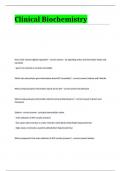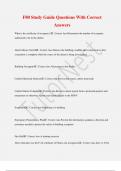Exam (elaborations)
Biology 310 Module 1 Study With Correct Answers (2025)!!
- Course
- Institution
BIOL 310 Study Material – Comprehensive & High-Quality Notes! Ace your BIOL 310 course with this well-organized and detailed study material! Perfect for students looking to save time, boost their grades, and understand key concepts quickly. What’s Included? Detailed Lecture Notes – C...
[Show more]












